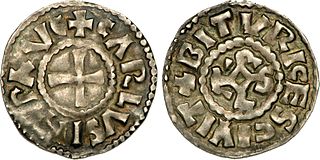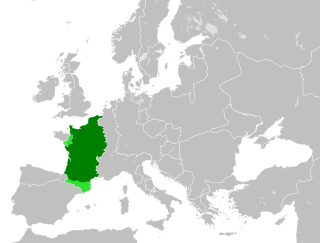Related Research Articles

Charles III, called the Simple or the Straightforward, was the king of West Francia from 898 until 922 and the king of Lotharingia from 911 until 919–923. He was a member of the Carolingian dynasty.

Robert I was the elected King of West Francia from 922 to 923. Before his election to the throne he was Count of Poitiers, Count of Paris and Marquis of Neustria and Orléans. He succeeded the overthrown Carolingian king Charles the Simple, who in 898 had succeeded Robert's brother, king Odo.

Lotharingia was a short-lived medieval successor kingdom of the Carolingian Empire. It comprised present-day Lorraine (France), Luxembourg, Saarland (Germany), Netherlands, and the eastern half of Belgium, along with parts of today's North Rhine-Westphalia (Germany), Rhineland-Palatinate (Germany) and Nord (France). It was named after King Lothair II, who received this territory after the Kingdom of Middle Francia of his father, Lothair I, had been divided among his three sons in 855.

Gisela of Burgundy, a member of the royal Elder House of Welf, was Duchess of Bavaria from about 972 to 976 and again from 985 to 995, by her marriage with Duke Henry the Wrangler. She was the mother of Emperor Henry II.

Rudolph, sometimes called Ralph, was the king of France from 923 until his death in 936. He was elected to succeed his father-in-law, Robert I, and spent much of his reign defending his realm from Viking raids.
William III, called Towhead from the colour of his hair, was the "Count of the Duchy of Aquitaine" from 959 and Duke of Aquitaine from 962 to his death. He was also the Count of Poitou from 935 and Count of Auvergne from 950. The primary sources for his reign are Ademar of Chabannes, Dudo of Saint-Quentin, and William of Jumièges.
Richard, Duke of Burgundy (858–921), also known as Richard of Autun or Richard the Justiciar, was Count of Autun from 880 and the first Margrave and Duke of Burgundy. He eventually attained suzerainty over all the counties of Burgundy save Mâcon and by 890 he was referred to as dux (duke) and by 900 as marchio (margrave). By 918 he was being called dux Burgundionem or dux Burgundiae, which probably signified less the existence of a unified Burgundian dukedom than feudal suzerainty over a multiplicity of counties in a specific region.
Gilbertof Chalon was count of Chalon, Autun, Troyes, Avallon and Dijon, and duke of Burgundy between 952 and 956. He became the ruler of the Duchy of Burgundy de facto. By his wife Ermengarde, he had two daughters: Adelais and Liutgarde. Gilbert never managed to maintain the independence of the duchy in the struggles for power of 10th-century France. In 952, he became a vassal of Hugh the Great, count of Paris, and married his oldest daughter, Liutgard, to Hugh's son Otto of Paris. Adelais married Robert of Vermandois.
Henry I, called the Great, was Duke of Burgundy from 965 to his death and Count of Nevers through his first marriage. He is sometimes known as Odo-Henry or Otto-Henry, since his birth name was "Odo" and he only adopted "Henry" on being elected duke of Burgundy.
The County of Auxerre is a former state of current central France, with capital in Auxerre.
Rudolph I was King of Upper Burgundy from his election in 888 until his death.
Rudolph II, a member of the Elder House of Welf, was King of Burgundy from 912 until his death. He initially succeeded in Upper Burgundy and also ruled as King of Italy from 922 to 926. In 933 Rudolph acquired the Kingdom of Lower Burgundy (Provence) from King Hugh of Italy in exchange for the waiver of his claims to the Italian crown, thereby establishing the united Kingdom of Burgundy.
Kingdom of Burgundy was a name given to various states located in Western Europe during the Middle Ages. The historical Burgundy correlates with the border area of France and Switzerland and includes the major modern cities of Geneva and Lyon.

The Kingdom of Upper Burgundy was a Frankish dominion established in 888 by the Welf king Rudolph I of Burgundy on the territory of former Middle Francia. It grew out of the Carolingian margraviate of Transjurane Burgundy southeast of ('beyond') the Jura Mountains together with the adjacent County of Burgundy (Franche-Comté) in the northwest. The adjective 'upper' refers to its location further up the Rhône river, as distinct from Lower Burgundy and also from the Duchy of Burgundy west of the Saône river. Upper Burgundy was reunited with the Kingdom of Lower Burgundy in 933 to form the Kingdom of Burgundy, later known as Kingdom of Arles or Arelat.

In medieval history, West Francia or the Kingdom of the West Franks refers to the western part of the Frankish Empire established by Charlemagne. It was the forerunner of the future Kingdom of France and existed from 843 to 987. West Francia emerged from the partition of the Carolingian Empire in 843 under the Treaty of Verdun following the death of Charlemagne's son, Louis the Pious.

Emma of France was a Frankish queen. The daughter of Robert I of France, she was a descendant of the powerful aristocratic Robertian family; her younger brother was Hugh the Great, the duke of the Franks and count of Paris.
The Robertians are the proposed Frankish family which was ancestral to the Capetian dynasty, and thus to the royal families of France and of many other countries. The Capetians appear first in the records as powerful nobles serving under the Carolingian dynasty of Charlemagne in West Francia, which later became France. As their power increased, they came into conflict with the older royal family and attained the crown several times before the eventual start of the continuous rule of the descendants of Hugh Capet.

Matilda of France, a member of the Carolingian dynasty, was Queen of Burgundy from about 964 until her death, by her marriage with King Conrad I.

Adelaide of Auxerre was a Duchess consort of Burgundy by marriage to Richard, Duke of Burgundy, and had the title Countess of Auxerre, possibly as ruling Count.
Willa of Burgundy was a member of the Elder House of Welf. By birth she was a daughter of Rudolph I of Burgundy, king of Upper Burgundy. Through marriage Boso Willa became countess of Avignon and Arles, and then margravine of Tuscany.
References
- 1 2 Bourchard, Constance Brittain (1999). "Burgundy and Provence:879-1032". In Reuter, Timothy; McKitterick, Rosamond; Abulafia, David (eds.). The New Cambridge Medieval History: Vol. III, c.900 - c.1024 (Link is extract=Volume III, Chapter 1 "Introduction: Reading the Tenth Century") (PDF). Vol. III (1. publ. ed.). Cambridge: Cambridge University Press. p. 336. ISBN 0521364477 . Retrieved 28 Feb 2013.
- ↑ Jean Dunbabin, France in the making: 843-1180, (Oxford University Press, 2000), 65.
- ↑ Constance B. Bourchard, Those of my Blood: Constructing Noble Families in Medieval Francia, (University of Pennsylvania Press, 2001), 146-147.
- ↑ Raphaël Bijard. "La construction de la Bourgogne Robertienne (936 - 1031)". Academia.
| Preceded by Rudolph | Duke of Burgundy 923 – 952 | Succeeded by Gilbert |